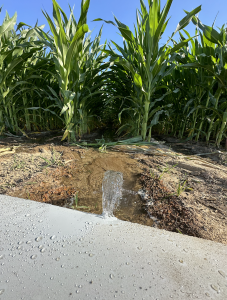“We’re always only five days from a drought.” That’s the saying here in the Delta. And for good reason. These light soils are unforgiving, as they lack the water holding capacity of those in the Midwest. Case in point this season: after a very wet May in Memphis – where we received nearly seven inches of rain, and a few spot showers in early June – Mother Nature has shut off her faucet. Last weekend, prior to my business trip, I scouted my corn. It had just reached canopy and looked amazing. My return at the end of last week told a much different story. The leaves were rolled up and some plants were firing. Rolling leaves are not uncommon; they are a corn plant’s natural defense mechanism to reduce moisture loss. But this does place stress on the plants. It was hard to believe this was the same field I saw just days prior. With no rain forecast for over a week, and temperatures expected near 100 degrees over the next several days, we watered the crop, the Delta way, using furrow irrigation. During May, the hipped hills we built served another purpose: they helped keep the plants above water and prevented them from getting flooded, as the excessive rainwater was kept in the furrows. Now, the furrows serve as channels to move water down the rows. Here’s how it works: we rolled poly pipe along the turn rows (near the crop), hooked it up to a pump, and turned on the water. We then poked holes in the poly pipe, aligning the holes with the furrows in the field, which enabled water to run down the rows. In about four hours, water had run entirely down the rows. We left the water running overnight, ensuring a thorough soaking. Within a couple of hours after releasing water, the plants near the turnrows did an about face and by morning the entire field looked great. Typically, after such a watering, the top of the soil will remain moist for over a week. Based on long-term forecast models, I don’t expect this to be the last watering.

Before and After Irrigation

The “five days away from a drought” reality is why improving soil health is so important. Every 1% increase in organic matter results in 25,000 gallons of available water per acre. And contrary to popular belief, significant soil health improvements don’t take that long. By incorporating regenerative agriculture practices – cover crops, manure and soil enhancers such as humic-based products – many growers have increased OM by 1% in just five years.
Despite the dry conditions, my corn is progressing rapidly. It’s now reached the V9 stage and is now growing like a teenage boy. And eating like one too. That’s why we’ll pull tissue samples this week and feed it accordingly. I’ll also apply Crop Gard, since along with our high humidity, the dense foliage can trap moisture, making the plants susceptible to disease. At the pace the corn is growing, I would expect to see tassels shoot this month. So I’ll make sure it’s well fed and stress free during this most critical period.
Fertilizer prices continue to fall well below 2023 levels. Compared to June last year, 32% UAN is down 15% and potash is down 18%. But the declining prices are starting to stabilize a bit. There is one fertilizer on the rise, as 10-34-0 has risen this month to $642 per ton.
Related Posts

This Week in Ag #37
One of the greatest inventions in history is the combine. The concept of threshing and separating grain in one operation revolutionized our food system, as well as redefined our labor force. Consider that in the mid-1800s, 90% of the US workforce was involved in some aspect of farming. Now it’s under 2%. To think my grandfather harvested corn by hand and threw the ears in a wagon! He used the pull-behind model in the 1940s to harvest small grains (that’s him, Fred Nichols, combining oats on our family farm). My mother still talks about dad wearing a Jesse James style mask while operating their first self-propelled combine without a cab.

This Week in Ag #8
Farmers love to grow corn. Only twice in modern history has corn not held the title of the most-grown crop in the USA. That was in 2018 and (if you count it) 1983, when the government’s PIK program artificially swayed planting practices. Spurred by record fertilizer prices, many projected soybeans would overtake corn last year

This Week in Ag #28
The recent fertilizer market may be best described by two catch phrases: “wait-and-see” and “just in time.” In the fall of 2021, sky-rocketing energy prices pointed toward looming inflation and an inevitable rise in fertilizer prices. Many savvy growers, including those aligned with the regen ag movement, hedged their bets by purchasing crop nutrients that

